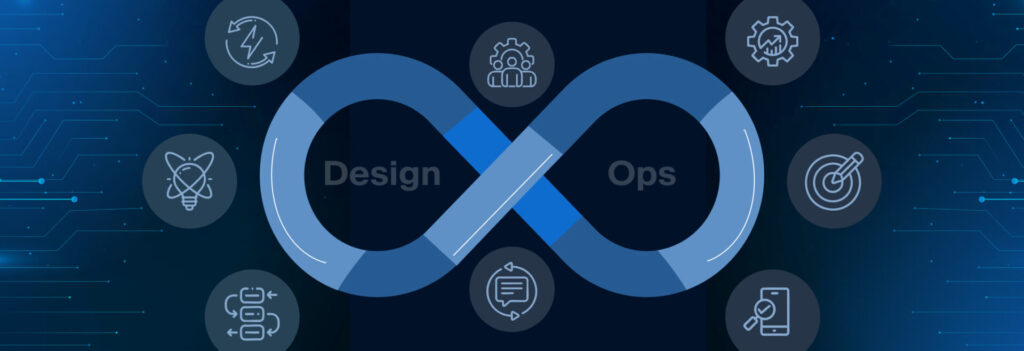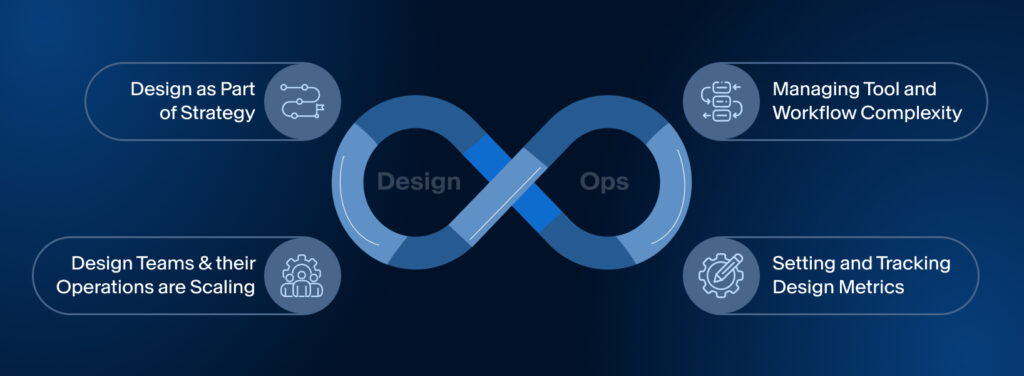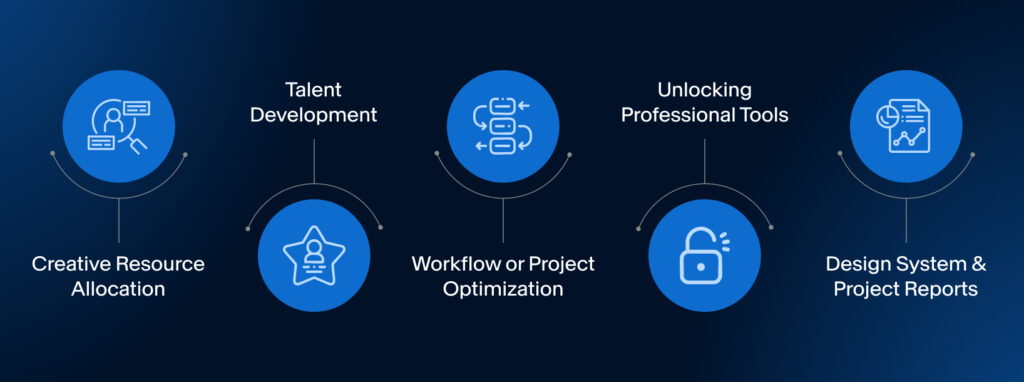For years, design teams thrived on creative freedom, attributing to inspiration, collaborative energy, and a deep understanding of users. But as the industry evolved to identify design as an integral part of the product development lifecycles, it matured into a strategic function and its challenges evolved. Scaling teams and professionals’ roles, managing complex workflows, and aligning creative output with the designated business goals called for a new discipline—Design Operations.
Once a niche role, design operations, also commonly known as DesignOps, is now becoming a crucial pillar for organizations that treat design as an edge over their competitors. It is the connecting bridge between creativity and efficiency in product development, ensuring design teams work not only to create stellar outcomes but also effectively, sustainably, and in sync with the broader business.
Stuti Mazumdar - October 2025

What is Design Operations?
At its core, DesignOps is about creating the conditions for great design to happen at scale. It applies operational thinking and processes to the creative process of a team, thereby removing friction, optimizing internal workflows, fueling collaboration, and aligning design output with business objectives at all times.
If you think of design as a product, DesignOps is the product’s infrastructure. It ensures consistent quality in outputs; streamlines tools, systems, and processes so designers don’t waste time reinventing workflows; makes room for UX professionals—not just designers—to focus on shipping creative outcomes while still meeting delivery commitments and quality standards.
Who Typically Manages DesignOps?
DesignOps can be carried out by a dedicated DesignOps team, a single specialist considering it has become a growing need of organizations across the globe. It can even be absorbed into the responsibilities of existing design leaders depending on the size and maturity of your organization.
In smaller teams, the role might naturally fall to a product or design manager who streamlines processes alongside their sprints. Larger organizations often appoint dedicated DesignOps professionals with the sole focus on building scalable processes or internal systems that help optimize workflows and ensure designers have the resources they need. In all cases, the function exists to remove operational roadblocks so that design teams can focus on delivering high-quality, user-centered outcomes.
Why is This Practice Rising Now?

The need for DesignOps in corporate systems didn’t appear overnight. Its rise is driven by a combination of industry shifts. Let’s take you through some of them:
1. Design as part of strategy
Design is no longer the last mile activity in a product development cycle, used only for polishing interfaces. It now shapes product strategy, differentiates brands from competitors, and builds long-term customer loyalty. As organizations place design at the center of decision-making, the stakes are now higher than ever. Without DesignOps, teams risk being unable to meet both the creative and strategic demands placed on them by an organization.
2. Design teams & their operations are scaling
As design teams continue to grow from a handful of UX professionals to dozens, working cohesively in silos for multiple business verticals within an organization often spread across time zones, informal processes collapse. Without a central system to govern quality and metrics to target, teams can create conflicting patterns, duplicate work, or spend more time coordinating than designing. DesignOps puts governance structures in place to manage this growth effectively.
3. Managing tool and workflow complexity
Today’s design workflow involves an intricate stack—several design tools, brainstorming tools for stakeholders, prototyping platforms for usability testing, project management tools for tracking, and internal tools for communication within the team. Without a clear operational structure, these tools can overwhelm any professional, rather than enable their creative process. DesignOps evaluates, integrates, and standardizes tool usage so the team spends less time managing technology and more time creating value for an organization.
4. Setting and tracking design metrics
Executives want to see how design teams, or rather creative teams, contribute to business outcomes. DesignOps helps establish metrics such as turnaround time for output, reduction in rework, faster time-to-market, or increased adoption of features—providing the evidence to show design is a business accelerator, not a cost center.
What Are DesignOps Operations Like?

DesignOps is a multidisciplinary practice, working in alignment with various teams with a range of capabilities. But it most often includes the following:
1. Creative Resource Allocation
By tracking project needs and the skills of a UX professional, DesignOps helps ensure the right people are part of the right projects at the right time, avoiding overloading some team members while underutilizing others.
Additionally, they also help recruitment specialists hire the right professionals possessing the right skillset to “complete” the team, since they have deep knowledge about how the existing team functions.
2. Talent Development
DesignOps supports onboarding for new hires, manages their workload, creates upskilling programs, helps them get the best guidance from appropriate mentors, and ensures their career paths are distinct. This fosters employee retention and ensures the team’s capabilities grow in step with business demands.
3. Workflow or Project Optimization
Instead of leaving project flow to chance, DesignOps builds clear pipelines so every UX professional knows exactly where their work sits, who’s involved, what deliverables are, how they can track their appointed metrics, and what’s next. This eliminates bottlenecks and last-minute scrambles.
4. Unlocking Professional Tools
DesignOps ensures that teams use the right tools for the right purposes. Ensuring that the licenses are well-managed and everyone has access to the latest versions are also responsibilities of a DesignOps manager. This minimizes compatibility issues and wasted subscriptions while promoting consistent workflows.
5. Design System & Project Reports
A living design system is a key part of scaling design. DesignOps ensures it is well-documented, accessible, and regularly updated, allowing teams to design faster and with more consistency. Taking it a step further, DesignOps also manages the adoption rates of these design systems to usability test outcomes, tracking KPIs that show both design efficiency and its contribution to business success.
The Intersection of Creativity and Business Efficiency
One of the biggest misconceptions about DesignOps is that it’s purely operational. In reality, it plays a protective role for creativity:
1. Creating Focus
Without DesignOps, designers and other UX professionals often lose time in administrative tasks, such as tracking feedback, generating feedback reports, hunting for brand assets, and more. By taking this off their plates, DesignOps allows creative minds to focus on solving problems and innovating.
2. Enabling and Leveraging Collaboration
DesignOps fosters alignment between product managers, engineers, designers, and writers by ensuring everyone works from the same guidelines and timelines, reducing misunderstandings and rework.
A big part of leveraging collaboration is creating a consistent design language that builds user trust. DesignOps safeguards this by maintaining visual and interaction patterns across platforms, preventing experience gaps.
3. Driving Measurable Impact
Identifying metrics that help measure creative value is often difficult for UX professionals. By connecting design activity directly to business outcomes, DesignOps helps organizations and the team see design as a strategic lever rather than a service function.
Key Principles for Successful DesignOps
User-Centric
Every operational decision, from which tools to adopt to how reviews are structured, should be guided by the impact on the end user.
Right-Sized Processes
DesignOps tailors its systems to team size and business goals, ensuring agility remains intact while improving predictability.
Continuous Feedback Loops
Regular retrospective cycles help adapt workflows to changing needs, preventing stagnation within the team.
Data-Driven Decision Making
DesignOps should rely on hard data, such as project turnaround times, design adoption rates, and customer satisfaction scores to inform process changes.



